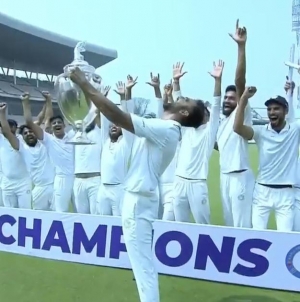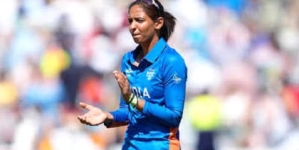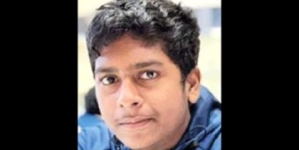-
LONDON: Indian-Origin Teen In UK Gets “Life-Changing” Cancer Treatment - 2 days ago
-
SILICON VALLEY: All About Pavan Davuluri, New Head Of Microsoft Windows - 2 days ago
-
LONDON: UK’s India Gate To Commemorate Role Of Indian Soldiers From World Wars - April 24, 2024
-
HARARE: Shri Bramha Kumar appointed as the next Ambassador of India to the Republic of Zimbabwe - April 23, 2024
-
LONDON: Indian-Origin Principal Wins UK Legal Challenge Over School Prayer Ban - April 23, 2024
-
TORONTO: Indian-Origin Doctor Needs ₹ 2 Crore For Legal Fees. Elon Musk Responds - April 22, 2024
-
KINSHASA: India-Democratic Republic of Congo Foreign Office Consultations - April 21, 2024
-
LONDON: UK Court Allows Sale Of Nirav Modi’s Luxury London Apartment - April 21, 2024
-
TEHRAN: Travel advisory for Iran and Israel - April 20, 2024
-
LUXEMBOURG: Shri Saurabh Kumar concurrently accredited as the next Ambassador of India to the Grand Duchy of Luxembourg - April 20, 2024
NEW DELHI: Open season in Indian cricket
NEW
DELHI: Just like the pace bowling unit
measured up to the demand, the opening department too withstood the churn,
though the talk was more about technique of the personnel than discussion about
growing options.
As India
made a sensational comeback to win a second successive Test series in Australia
early this year, their seemingly endless pace resources, following injuries to
their senior quartet, made it a remarkable achievement.
There was
another, quieter, revolution, at the other end of the scale so to say, that
didn’t register in the manner of how India projected themselves as a pace power
that is second to none in terms of effectiveness regardless of conditions.
That is
the depth in their opening department. Just like the pace bowling unit measured
up to the demand, the opening department too withstood the churn, though the
talk was more about technique of the personnel than discussion about growing
options. It was Prithvi Shaw and Mayank Agarwal in Adelaide, Shubman Gill made
his debut in the next Test at MCG and partnered Agarwal while Rohit Sharma took
his place in the last two Tests alongside Gill.
KL Rahul
waited in the wings for a chance that didn’t come, while Shaw had already
started ironing out his technical flaws. At one level, a quality opener is like
a “fox in the box” striker in football. The search is constantly on, and it is
often about making adjustments. Indian openers are judged on how they perform
in overseas conditions, where the ball swings, seams and bounces a lot more.
The jury is still out on that count but it is a kind of overcrowding that
actually gives the team management breathing space as far as finding better
options is concerned.
It has
definitely ended a waiting period. The “who will be the next Gavaskar?” took
more than a decade to be answered. Even then Virender Sehwag batted at No.6 or
No.7 in his first five Tests before being pitch-forked to open in challenging
conditions on the 2002 England tour. He opened for the rest of his 99 Tests.
Among players weaned as openers, Wasim Jaffer, in 31 Tests between 2000-08,
scored close to 2,000 runs. Gautam Gambhir played 58 Tests between 2004/5 and
2016/17, scoring more than 4,000 runs. Fellow left-hander Shikhar Dhawan got to
play only 34 Tests from 2013 to 2018.
Although
Dhawan’s Test career petered out on that 2018 England tour, he had started with
the fastest Test century on debut. While IPL made fast bowling remunerative,
career-wise and cash-wise, the T20 league has also showed the path for openers.
Aggression and power pays in IPL, after patience and honing of technique at
domestic level ensures durability and readies a batsman to face international
bowlers.
Thus a
jostling for the openers’ slots in the last few years. Mayank Agarwal had to
fight his doubts and score heavily at domestic level to be selected as India
opener. He played a key role in the 2018-19 series win in Australia. His
Karnataka, India and IPL teammate KL Rahul too has been an opener from the time
he started playing as a young boy.
Rahul’s
coach Samuel Jayaraj recalls: “He started coming to me at the Mangalore Sports
Club from the age of 10-and-half years. He was always an opener. He opened in
all age-groups for Karnataka—under-13, under-15, under-17 and under-19,” he
said.
Among the
younger brigade, Prithvi Shaw and Shubman Gill, who won the U-19 World Cup
together in 2018, were both openers. Both are a great example of India’s junior
programme—age-group and India A—helping young players settle down in their
preferred roles.
Shaw’s
father, Pankaj, says: “When my son started playing in Virar (at a ground in
Yashwant Nagar) as a seven-year-old, he used to go first to bat when he started
playing matches with small kids. He continued to open when he started playing
for his school team, and train at the MIG Cricket Club, Bandra, at an age of
seven-and-half years. It just continued and he remained an opener. We never
thought of middle-order. I didn’t even know what middle-order was until later.”
Devdutt
Padikkal, the 20-year-old Karnataka left-handed opener who had a breakout IPL
season with Royal Challengers Bangalore and then scored four centuries in the
just-ended Vijay Hazare Trophy one-day tournament, has also started to push his
case. His brief career is an example of youngsters willing to take the
limited-overs route, until the first-class route in the past, to play at the
highest level.
His
father Padikkal feels his son’s impatience settled the non-debate about his
becoming an opener. “He made himself an opener because he wanted to bat first,
that was the case. He didn’t want to sit (and wait) for a long time; first of
all, he would get ready and bat first, that’s how he became an opener. From
when he was seven-eight years old he was an opener. From the first match itself
he opened. He put the pads on and even before the coach told him, went out and
started batting.”
Wonder
what India’s golden generation of batsmen, be it Rahul Dravid, Sachin Tendulkar
or VVS Laxman who have all opened for India in different situations, would
think of this eagerness. The current Test openers though took a more
conservative route.
Rohit
Sharma, finally enjoying his conversion into a Test opener, started his India
career in 2007 in the middle-order, one with great touch in his shots. His
talent encouraged skipper MS Dhoni to promote him during the 2013 ICC Champions
Trophy in the UK. That was the turning point in his career, as Sharma became
one of the best openers in the world, especially in limited-over formats.
Sharma’s
Test returns were subdued in the middle-order, but coach Ravi Shastri and
skipper Virat Kohli successfully gambled by asking him to open in Tests. It is
a story similar to the start of his career. His childhood coach Dinesh Lad
says: “In our school team (Swami Vivekanand, Borivali) first, I played him as a
bowler and lower-order batsman, but once I realised his batting potential, I
made him open. For three years, he played as an opener. His success as an
opener at the international level didn’t come as surprise to me,” says Lad.
“When he started playing for Mumbai age-group teams, he started playing in the
middle-order because a new player can’t decide for himself what number he has
to bat.”
Shubman
Gill, handed his debut at MCG and who impressed with the time he has to play
shots–he was also left to analyse his technique by England bowlers in the
recent home Test series–batted at No.3 in the U-19 World Cup. He scored 372
runs at an average of 124.00. But he started as an opener in 2014, scoring 351
runs in Punjab’s Inter-District Under-16 tournament. He even shared a record
opening stand of 587 runs with Nirmal Singh.
What is
really working for India in building a bank of openers is that the
temperament-first approach has been long junked. T20 cricket has allowed young
batsmen to find their way of dealing with the challenge of the new ball. Like
how India got really good at bowling with it.
As for
the trend of openers, Lad, who is also the coach of Shardul Thakur, says the
opportunities are more batting at the top of the order. “You get more time in
the limited overs game. You get scoring chances in the power play with field
restrictions, and if you get seven-eight boundaries, you have a decent score on
the board; after that you can pace your innings. It means, you have a better
chance of getting noticed.”






















